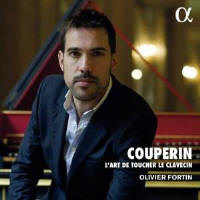Texte paru dans: / Appeared in: |
|
|
Outil de traduction ~ (Très approximatif) |
|
|
Reviewer: Bradley
Lehman Olivier Fortin plays the eight preludes of L’Art de Toucher le Clavecin (a primer for harpsichord students) interspersed with 17 pieces from Couperin’s four other books of harpsichord music. Instead of playing the preludes in Couperin’s published sequence, he arranges his program to proceed upward by steps of the scale: C, D minor, E minor, F, G minor, A, B-flat, and B minor. After each prelude he plays a few pieces in related keys. This strategy seems wiser than playing the preludes sequentially as a set.
He plays Gustav Leonhardt’s “Lefebvre 1755” harpsichord designed and built by Martin Skowroneck in the early 1980s as a “forgery without intent to defraud”. It was a practical experiment in building a pseudo-antique from scratch with old-fashioned tools and techniques. Leonhardt made at least three solo recordings on this deluxe harpsichord, performing French music and Bach pieces. After Leonhardt’s death in 2012, Aya Hamada played this instrument for a brilliant recording of Duphly’s music (N/D 2015). She and Fortin sound different from Leonhardt. Fortin plays the most simply of the three, usually letting his phrases flow with fewer nuances in the gestures. Part of the difference in tone might be from the hardware—most of this harpsichord was restrung with mellower wire since Hamada’s recording.
Fortin interprets the didactic preludes more as musical lessons than technical ones. Joyce Lindorff (N/D 2018) made them seem more self-conscious and unfortunately sometimes clumsy and badly tuned. She also neglected to correct the source’s misprinted bass note near the end of Prelude 3. Gustav Leonhardt recorded these eight preludes in 1987 on one of his other Skowroneck French harpsi-chords (Philips, not reviewed). Leonhardt gave more attention to the ends of notes, letting his finger releases function like the percussive consonants in speech. Fortin gives us smooth vowels while making the pieces sound more personalized and improvisatory than Leonhardt. His treatment of Prelude 4 is especially poignant.
For the 17 freely chosen pieces, Fortin has avoided most of the typical “greatest hits” that harpsichordists learn first. It’s refreshing. He plays his selections beautifully and almost perfectly. perfectly. He mis-learned two of the middle voice’s notes in ‘Les Ombres Errantes’, reading them with wrong accidentals (naturals vs flats), and it happens again in each repeat. Everything else has a comfortable “rightness” and a gentle smile that makes this program easy to listen to. This is a terrific single CD to introduce anyone to Couperin’s music.
| |
|
|
|
|
Cliquez l'un ou l'autre
bouton pour découvrir bien d'autres critiques de CD |
|



